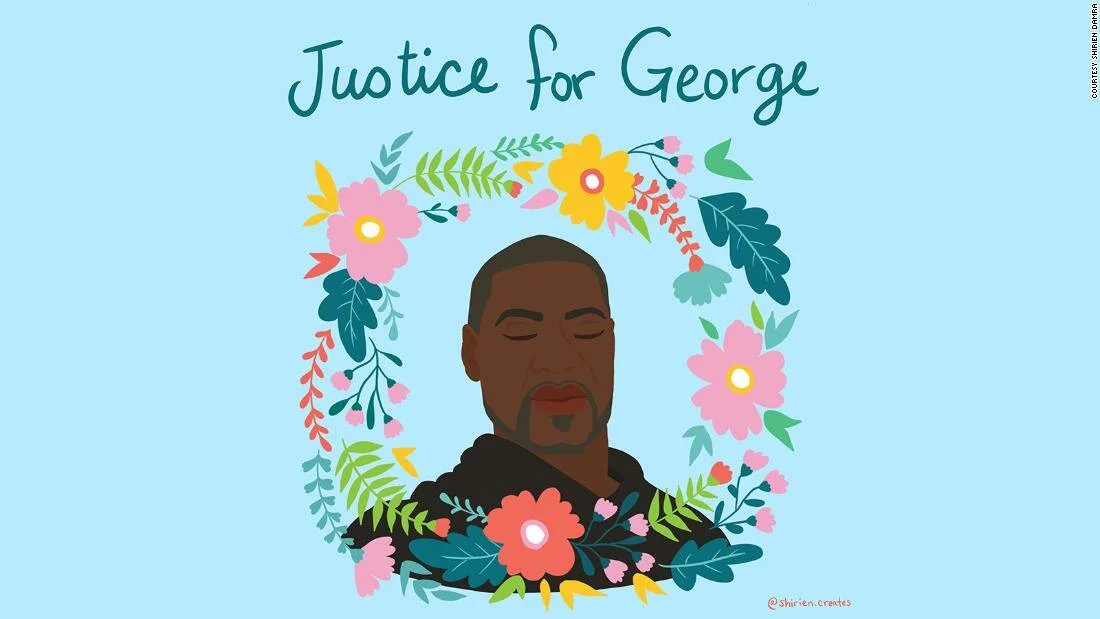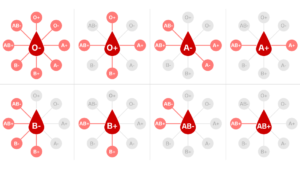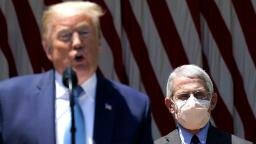This feature includes artwork with language that some might find offensive.
“This latest case of police brutality was yet another injustice that moved me to paint a tribute to give honor and a voice to a voiceless victim,” said the 35-year-old over email.

A portrait of George Floyd by Nikkolas Smith Credit: Nikkolas Smith
Smith’s digital portrait of Floyd wearing a suit was shared by organizers of the Black Lives Matter movement and Michelle Obama on Instagram. Obama wrote: “Like so many of you, I’m pained by these recent tragedies … Right now it’s George, Breonna, and Ahmaud. Before that it was Eric, Sandra, and Michael. It just goes on, and on, and on.”
‘I can breathe now’
For the artists, creativity is a powerful way for the community to speak out.
1/10
TOPSHOT – Flowers, signs and balloons are left near a makeshift memorial to George Floyd near the spot where he died while in custody of the Minneapolis police, on May 29, 2020 in Minneapolis, Minnesota. – Demonstrations are being held across the US after George Floyd died in police custody on May 25. (Photo by Kerem Yucel / AFP) (Photo by KEREM YUCEL/AFP via Getty Images) Credit: KEREM YUCEL/AFP/AFP via Getty Images
“George Floyd was killed in my neighborhood, where I have lived all of my life. It is a clear and unequivocal action of police brutality,” said community and public artist McLain over email.
McLain was approached by Goldman to join the project. “This was our first time all painting together,” she said of her co-artists, who had met the previous year at a training session for Latinx muralists. Though the process for such pieces is usually much longer, thley were looking for a “permanent shift” in the intersection’s “visual landscape.”
“It was very fast, organized over Instagram…like, ‘who’s ready, let’s go!'” McLain said. “My studio was able to provide the paint and we were able to move quickly.”
This was the first mural that 45-year-old Belize-born Cadex Herrera had completed, after he had started as a mural apprentice with a local non-profit last year. As an art educator and intervention specialist at an elementary school, he felt compelled to create something meaningful after hearing about Floyd’s death.

The artists stand in front of the George Floyd memorial mural that they painted in Minneapolis. From left to right: Niko Alexander, Cadex Herrera, Greta McLain, Xena Goldman, Pablo Helm Hernandez. Credit: courtesy Cadex Herrera
“My emotions were so raw,” he said over email. “The hurt is so deep and the wound won’t heal because it opens up every time a person of color is killed unjustly and it doesn’t stop.”
For him, art can help heal. “Art is therapy. Art can say things you cannot express with words. It brings the community together to reflect, to grieve, for strength and for support.”
He, McLain and Goldman were helped by artists Maria Javier, Rachel Breen, Niko Alexander, and Pablo Helmp Hernandez, however the final detail on the mural, the words ‘I can breathe now,’ were added by someone else, and reference the words repeated by Floyd in the video of the killing: “I can’t breathe.”
“The phrase came from an African American community member, Anjel Carpenter, who approached us and asked for it,” McLain said. “She then surveyed the community, asking them if they preferred ‘I can breathe now,’ ‘Let me breathe,’ and one more, and they voted for ‘I can breathe now.’ We asked another member of the community to paint those words in.”
“(Carpenter) expressed to us that the idea of not being able to breathe was fueling so much tension and anger,” McLain continued. “And that now George was with God and it was important for our community healing to claim our breath and ability to breathe.”
Justice for George
Thirty-three-year-old Shirien Damra says she is relatively new to Instagram, but her memorial image dedicated to George Floyd, “Justice for George,” has already received over three million likes since she posted it the day after Floyd was killed. Her work has been widely shared, including by congresswomen Alexandria Ocasio-Cortez and Rashida Tlaib.
A native of Chicago, Damra is the daughter of Palestinian refugees and wants her work, which brings together bold and soft colors, to resonate as “loving” and “calming, yet hopeful.”
“I know the power of color and the emotion it can implicitly evoke,” she said over email. “I hope that my colors and imagery help the viewers process difficult emotions and events and come out of it with some hope and inspiration.”

“Justice for Breonna” by Shirien Damra Credit: Courtesy Shirien Damra

“Justice for Ahmaud” by Shirien Damra Credit: Courtesy Shirien Damra
“I wanted these pieces to be a gesture of solidarity with Black communities in their time of grieving,” she said. “I noticed a lot of people sharing the videos of Ahmaud and George’s deaths, so I wanted to create an alternative. These videos are very traumatic and triggering.”
“He was a 17-year-old kid who was seen as suspicious for wearing a hoodie,” Damra said. “It’s a disturbing pattern that happens each time we hear news of another victim of anti-Black violence. My way of challenging this was to carefully choose bright colors and florals to honor their memory and celebrate their lives in a beautiful way.”
Necessary acts

“I can’t breathe” by Láolú Senbanjo Credit: Láolú Senbanjo
“When I see video of men like George Floyd treated as far less than human, I can barely comprehend it,” 39-year-old Senbanjo said over email. “His proud face smashed into the pavement. It breaks my heart apart. I’ve been black all my life, but for the first twenty years I was black in Africa (Nigeria). Now I’ve been black in America and it is a different experience. America doesn’t honor what they have in their black citizens. I couldn’t not make art about the killing of George Floyd.”
Senbanjo said that art can help with processing trauma: “Every time there is a new senseless death, or blatant manifestation of harmful white supremacy, art can help us to instigate, remember, imagine, discuss, and express these complex experiences and feeling states.”
Do the right thing
Theoplis Smith III was born and raised in St Louis, Missouri, and his recent artwork of Floyd presents him wearing the “Love” and “Hate” four-knuckle rings worn by Radio Raheem (played by Bill Nunn) in Spike Lee’s 1989 movie, “Do The Right Thing.” In the movie, the unarmed Raheem is choked to death by a police officer.
“Seeing this movie as a child, I never imagined that what happened to Radio Raheem the character in the movie, I would not only see on an eight-minute video happening to a man before my eyes, but have to sit and discuss with my 16-year-old black son,” the 38-year-old former banker said over email, referring to Chauvin’s use of a knee-to-neck restraint maneuver on Floyd, which allegedly led to his death. Smith’s post of his artwork was shared by Spike Lee’s own Instagram account.

Memorial artwork by Theoplis Smith III, depicting George Floyd as Radio Raheem, from Spike Lee’s “Do The Right Thing.” The character is choked to death in the film Credit: Courtesy Theoplis Smith III
“Unfortunately, having to create out of many negative circumstances isn’t my favorite thing to create, but it is often my most impactful.”
Art for now and the future
When art is used to bring attention to social issues, it can connect with people in ways that other forms of political engagement cannot, Damra in Chicago said.
“Art can touch the emotional core of what moves us toward social justice in ways that a strategy meeting or news or political analysis can’t. Murals, graffiti and paintings are a chance for communities to come together and speak their mind or represent themselves in public space.”
The message, for Damra, is clear: “We don’t want any more Black lives targeted by police and white supremacy.”
McLain wrote that it was crucial for white people to be loud and active about the “decades of police violence and injustice directed at people of color,” adding: “The incredible racism and violence that our communities of color have been experiencing… is NOT ok and we all need to stand and demand change. We cannot be quiet!”
Similarly Herrera in Minnesota wants the mural to remind people of the message that “Black Lives Matter.” He wrote that we must all “stand up for people of color who are singled out, harassed, brutalized, mistreated and murdered by law enforcement every day.”
Smith in Los Angeles said the importance of social justice art is to galvanize people, and to help them look to a better future. “Art during these volatile times in history can either aggressively wake people up to reflect what is broken, or paint a hopeful picture of what could be, showing us a way forward.”
Source link






Be First to Comment